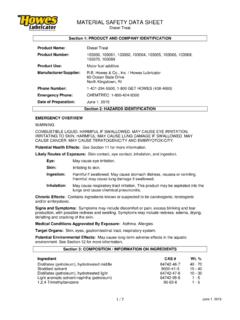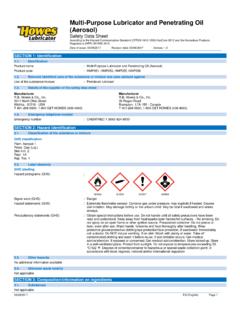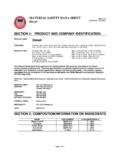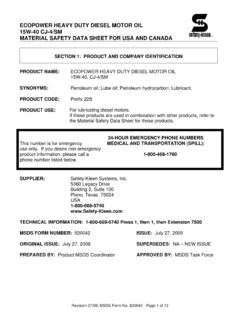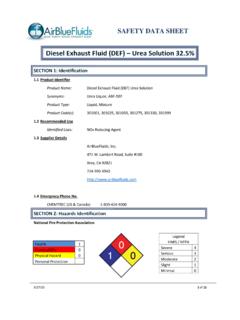Transcription of Diesel Treat - Howes Lubricator
1 Diesel Treat safety data sheet according to the Hazard Communication Standard (CFR29 ) HazCom 2012. Date of issue: 06/01/2015 Revision date: 06/01/2015 Version: SECTION 1: Identification of the substance/mixture and of the company/undertaking Product identifier Product name : Diesel Treat Product code : 103060, 103061, 103062, 103064, 103065, 103066, 103068, 103070, 103089. Relevant identified uses of the substance or mixture and uses advised against Use of the substance/mixture : Motor Fuel Additive Details of the supplier of the safety data sheet Howes & Co., Inc. / Howes Lubricator 60 Ocean State Drive North Kingstown, RI. T 401-294-5500, 1-800 GET Howes (438-4693). Emergency telephone number Emergency number : CHEMTREC 1 (800) 424-9300. SECTION 2: Hazards identification Classification of the substance or mixture GHS-US classification Flammable Liquid 4. Skin Irritation 2. Carcinogenicity 2. Specific target organ toxicity - Repeated exposure 1.
2 Aspiration Toxicity 1. Label elements GHS-US labelling Hazard pictograms (GHS-US) : GHS07 GHS08. Signal word (GHS-US) : Danger Hazard statements (GHS-US) : Combustible liquid. Causes skin irritation. Suspected of causing cancer. Causes damage to organs through prolonged or repeated exposure. May be fatal if swallowed and enters airways. Precautionary statements (GHS-US) : Keep away from flames and hot surfaces. No smoking. Wash hands thoroughly after handling. Obtain special instructions before use. Do not handle until all safety precautions have been read and understood. Wear protective gloves/protective clothing/eye protection/face protection. Do not breathe dust/fume/gas/mist/vapors/spray. Do not eat, drink or smoke when using this product. If exposed or concerned: Get medical advice/attention. If on skin: Wash with plenty of water. If skin irritation occurs: Get medical advice/attention. Take off contaminated clothing and wash it before reuse.
3 If swallowed: Immediately call a poison center/doctor. Do NOT induce vomiting. Store in a well-ventilated place. Keep cool. Store locked up. Dispose of contents/container in accordance with local/regional/national/international regulations. Other hazards No additional information available. Unknown acute toxicity (GHS-US). 31 percent of the mixture consists of ingredient(s) of unknown acute toxicity. SECTION 3: Composition/information on ingredients Substance Not applicable. 06/01/2015 EN (English) Page 1. Diesel Treat safety data sheet according to the Hazard Communication Standard (CFR29 ) HazCom 2012. Mixture Name Product identifier % GHS-US classification Distillates, petroleum, hydrotreated middle (CAS No) 64742-46-7 40 - 70 Flam. Liq. 4. Acute Tox. 4 (Inhalation). Asp. Tox. 1. Stoddard solvent (CAS No) 8052-41-3 15 - 40 Skin Irrit. 2. STOT RE 1. Asp. Tox. 1. Petroleum distillates, hydrotreated light (CAS No) 64742-47-8 10 - 30 Flam. Liq. 3.
4 Asp. Tox. 1. Solvent naphtha, petroleum, light aromatic (CAS No) 64742-95-6 1-5 Flam. Liq. 3. Skin Irrit. 2. Eye Irrit. 2A. Asp. Tox. 1. Benzene, 1,2,4-trimethyl- (CAS No) 95-63-6 1-5 Flam. Liq. 3. Acute Tox. 4 (Inhalation). Skin Irrit. 2. Eye Irrit. 2A. STOT SE 3. Fatty acid amine reaction product Trade secret 1-5 Skin Irrit. 2. Eye Irrit. 2A. Nonane (CAS No) 111-84-2 1-5 Flam. Liq. 3. Acute Tox. 4 (Inhalation). Skin Irrit. 2. STOT SE 3. Asp. Tox. 1. Naphthalene (CAS No) 91-20-3 - 1 Acute Tox. 4 (Oral). Carc. 2. Ethylbenzene (CAS No) 100-41-4 < Flam. Liq. 2. Acute Tox. 4 (Inhalation). Skin Irrit. 2. Eye Irrit. 2B. Carc. 2. Asp. Tox. 1. Cumene (CAS No) 98-82-8 < Flam. Liq. 3. Carc. 2. STOT SE 3. Asp. Tox. 1. * The specific chemical identity and exact percentage (concentration) of composition has been withheld as a trade secret in accordance with paragraph (i) of SECTION 4: First aid measures Description of first aid measures First-aid measures after inhalation : If inhaled, remove to fresh air.
5 If not breathing, give artificial respiration. If breathing is difficult, give oxygen. Get medical advice/attention if you feel unwell. First-aid measures after skin contact : In case of contact, immediately flush skin with plenty of water. Remove contaminated clothing and shoes. Wash clothing before reuse. Call a physician if irritation develops and persists. First-aid measures after eye contact : In case of contact, immediately flush eyes with plenty of water. Remove contact lenses, if worn. If irritation persists, get medical attention. First-aid measures after ingestion : If swallowed, do NOT induce vomiting. Never give anything by mouth to an unconscious person. Get immediate medical advice/attention. Most important symptoms and effects, both acute and delayed Symptoms/injuries after inhalation : May cause respiratory tract irritation. Vapours may cause drowsiness and dizziness. Symptoms/injuries after skin contact : Causes skin irritation.
6 Symptoms may include redness, edema, drying, defatting and cracking of the skin. Symptoms/injuries after eye contact : May cause eye irritation. Symptoms may include discomfort or pain, excess blinking and tear production, with possible redness and swelling. Symptoms/injuries after ingestion : May be fatal if swallowed and enters airways. This product may be aspirated into the lungs and cause chemical pneumonitis. May cause stomach distress, nausea or vomiting. Indication of any immediate medical attention and special treatment needed Symptoms may not appear immediately. In case of accident or if you feel unwell, seek medical advice immediately (show the label or SDS where possible). SECTION 5: Firefighting measures Extinguishing media Suitable extinguishing media : Powder, water fog, foam, carbon dioxide. Unsuitable extinguishing media : Do not use water jet. 06/01/2015 EN (English) 2/1. Diesel Treat safety data sheet according to the Hazard Communication Standard (CFR29 ) HazCom 2012.
7 Special hazards arising from the substance or mixture Fire hazard : Products of combustion may include, and are not limited to: oxides of carbon. Advice for firefighters Protection during firefighting : Keep upwind of fire. Wear full fire fighting turn-out gear (full Bunker gear) and respiratory protection (SCBA). Use water spray to keep fire-exposed containers cool. SECTION 6: Accidental release measures Personal precautions, protective equipment and emergency procedures General measures : Use personal protection recommended in Section 8. Isolate the hazard area and deny entry to unnecessary and unprotected personnel. Eliminate sources of ignition. Methods and material for containment and cleaning up For containment : Contain and/or absorb spill with inert material ( sand, vermiculite), then place in a suitable container. Do not flush to sewer or allow to enter waterways. Use appropriate Personal Protective Equipment (PPE). Methods for cleaning up : Scoop up material and place in a disposal container.
8 Spilled material may present a slipping hazard. Provide ventilation. Reference to other sections See section 8 for further information on protective clothing and equipment and section 13 for advice on waste disposal. SECTION 7: Handling and storage Precautions for safe handling Precautions for safe handling : Keep away from sources of ignition - No smoking. Avoid contact with skin and eyes. Do not breathe dust/fume/gas/mist/vapors/ spray. Do not swallow. Handle and open container with care. When using do not eat, drink or smoke. Use only outdoors or in a well-ventilated area. Hygiene measures : Launder contaminated clothing before reuse. Wash hands before eating, drinking, or smoking. Conditions for safe storage, including any incompatibilities Technical measures : Proper grounding procedures to avoid static electricity should be followed. Storage conditions : Keep locked up and out of reach of children. Keep container tightly closed and in a well- ventilated place.
9 Keep cool. Specific end use(s). Not available. SECTION 8: Exposure controls/personal protection Control parameters Distillates, petroleum, hydrotreated middle (64742-46-7). ACGIH Not applicable OSHA Not applicable Stoddard solvent (8052-41-3). ACGIH ACGIH TWA (ppm) 100 ppm OSHA OSHA PEL (TWA) (mg/m ) 2900 mg/m . OSHA OSHA PEL (TWA) (ppm) 500 ppm Petroleum distillates, hydrotreated light (64742-47-8). ACGIH Not applicable OSHA Not applicable Solvent naphtha, petroleum, light aromatic (64742-95-6). ACGIH Not applicable OSHA Not applicable Benzene, 1,2,4-trimethyl- (95-63-6). ACGIH Not applicable OSHA Not applicable 06/01/2015 EN (English) 3/1. Diesel Treat safety data sheet according to the Hazard Communication Standard (CFR29 ) HazCom 2012. Fatty acid amine reaction product ACGIH Not applicable OSHA Not applicable Nonane (111-84-2). ACGIH ACGIH TWA (ppm) 200 ppm OSHA Not applicable Naphthalene (91-20-3). ACGIH ACGIH TWA (ppm) 10 ppm OSHA OSHA PEL (TWA) (mg/m ) 50 mg/m.
10 OSHA OSHA PEL (TWA) (ppm) 10 ppm Ethylbenzene (100-41-4). ACGIH ACGIH TWA (ppm) 20 ppm OSHA OSHA PEL (TWA) (mg/m ) 435 mg/m . OSHA OSHA PEL (TWA) (ppm) 100 ppm Cumene (98-82-8). ACGIH ACGIH TWA (ppm) 50 ppm OSHA OSHA PEL (TWA) (mg/m ) 245 mg/m . OSHA OSHA PEL (TWA) (ppm) 50 ppm Exposure controls Appropriate engineering controls : Use ventilation adequate to keep exposures (airborne levels of dust, fume, vapor, etc.) below recommended exposure limits. Hand protection : Wear chemically resistant protective gloves. Eye protection : safety glasses or goggles are recommended when using product. Skin and body protection : Wear suitable protective clothing. Respiratory protection : In case of insufficient ventilation, wear suitable respiratory equipment. Respirator selection must be based on known or anticipated exposure levels, the hazards of the product and the safe working limits of the selected respirator. Environmental exposure controls : Maintain levels below Community environmental protection thresholds.
